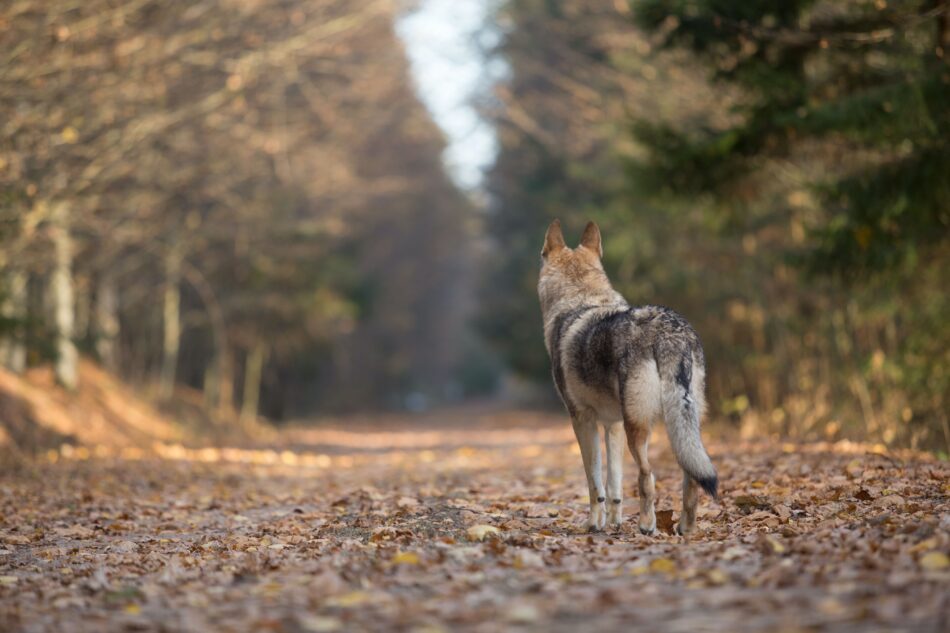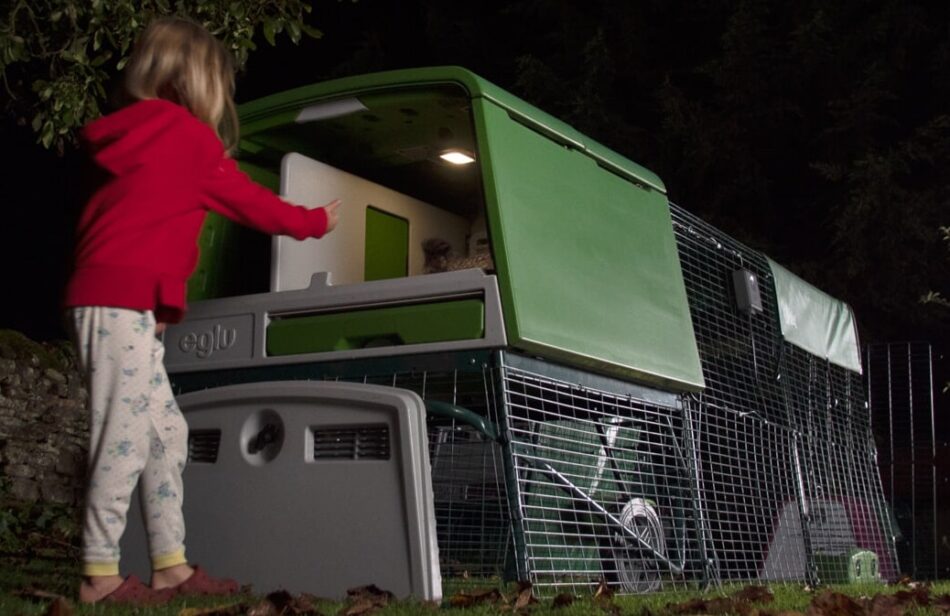Protect your chickens from coyotes

Most chicken keepers have to consider how to keep their chickens safe from coyotes.
Urbanization has encroached on natural coyote territories, increasing the sightings of this predator in residential streets and backyards. Notorious for being some of the most persistent of predators, coyotes will dig, scratch, bite, and push their way into many standard chicken enclosures. They’re also extremely agile and athletic, able to clear fences up to 8 feet tall.
Table of Contents
Where are coyotes found?
Coyotes can be found in 49 US states – with Hawaii being the exception. From the southern plains, to mountain regions, and even tropical climates, coyotes thrive in a variety of ecosystems. With such a wide territory, coyotes are one of the most common chicken predators that flock raisers encounter.
Being the intelligent and crafty creatures they are, coyotes have quickly learned that the presence of humans brings meal opportunities. Garbage is tempting to a coyote, but these wiley predators will take advantage of unprotected pets in even urban backyards – with chicken being a favorite among coyotes.
Why coyotes are a danger to chickens & signs of an attack
As a member of the canine family, coyotes have excellent scents of smell and hearing. While you may not always hear or smell your chickens, coyotes certainly do. Chickens make an ideal meal for a coyote due to their mild temperaments and high protein content.
Coyotes will most often try to dig into your chickens’ pen – which is why anti-dig skirting is so vital. Quick tunnels dug right next to the run allow a coyote to squeeze through in a manner of minutes. Anti-dig skirting is attached to the run at a 90° angle, extending out by several inches, helping to prevent this tunneling tactic.
You’ll notice dig marks or the beginnings of a tunnel if a coyote has visited your chickens’ run. You may also notice claw marks on the run and broken or bent chicken wire. Coyote’s footprints resemble those of a medium-sized dog – narrow, padded feet with 4 toes and claws.
Which coop is best to keep my hens safe from coyotes?
Wooden chicken coops are not always strong enough to withstand the advances of a determined coyote. Omlet’s line of heavy-duty plastic chicken coops offer superior predator protection. Predator-resistant setups are essential in keeping your hens as safe as possible from coyotes.
Ensure chickens are secured at night
Coyotes can be either nocturnal (most active at night) or diurnal (most active at dawn and dusk) depending on environmental factors. Most coyotes living close to urban areas will adopt a nocturnal schedule to come out while human residents are asleep. In more rural areas, it’s common to see coyotes roaming around sunrise and sunset.
Omlet’s Autdoor for easy coop security
Depending on your schedule and where you live, you’ll need to make sure your hens are closed safely in their coop during a coyote’s most active hours. An Automatic Chicken Coop Door Opener can be easily installed on a secure Eglu Cube Chicken Coop to follow a routine based on the sun or the clock. The open and close schedules are customizable to fine-tune your flock’s routine. This way, your chickens will be tucked in safely even if you aren’t home to close the coop door – making it one of the many reasons flock-raisers love the Autodoor.
The daylight setting of the Autodoor allows you to set the open and close times based on the amount of sunlight available. There is also an optional one-hour delay for this setting, which is particularly helpful during time changes in fall and spring. The amount of daylight is measured by a sophisticated light sensor on the Autodoor’s control panel, allowing you to adjust open and close times according to the readings.
The Autodoor’s time setting enables you to set specific open and close times. This is particularly useful for those in rural areas that need to keep their hens in the safety of their coop until the sun has fully risen, and that need to tuck them in before dusk.
Make sure the coop is well lit
Along with a predator-resistant chicken coop, you can add external safety features to deter coyotes. Coyotes are sensitive to light, so placing motion-activated lights around the perimeter of your property can help keep them at bay. These lights should not be left on all the time, as coyotes will eventually get used to them. You’ll want the “surprise” factor of motion lights. Some predator-specific motion lights use a strobe pattern or a series of different colored lights to further startle coyotes.
Your chickens will also appreciate a light in their hen house to signal that it’s time for bed. While coyotes will avoid lights, chickens are drawn to illumination once the sun starts to set. The Autodoor has an optional chicken coop light that can be added inside of your coop. The coop light integrates directly into the control panel of the Autodoor, and will turn on 5 minutes before the door is scheduled to close, and will automatically turn off once the Autodoor has closed.
The coop light can also be turned on manually at any time at the press of a button on the control panel, making late-night coop checks quick and easy. The soft glow of the coop light will not startle your hens out of their slumber, and will help bring you peace of mind.
Backyard maintenance
Keep your property free of materials that could be hospitable to coyotes. Fallen trees, dense brush or bushes, and spaces underneath outbuildings make great hiding or sleeping spaces for coyotes. Most coyotes will only use a den when raising their pups, but they will take advantage of cover close to a potential meal.
Coyotes may also be drawn to compost piles or the animals that frequent gardens. Many people who keep chickens also keep a garden, but prey animals such as gophers, moles, mice, and wild rabbits also appreciate your garden. These small animals are also favorites of coyotes, so take care to keep these critters away from your yard. Use garden fencing, sprays, or other deterrents to help keep animals away from your plants, and keep compost in a bin or far away from your chickens’ area.
Keep the coop clean
Small animals are also drawn to leftover food in your chickens’ coop and run. Mice in particular are difficult to keep out of a chicken coop. While they won’t harm your chickens, their movement and noises will draw coyotes in.
A chicken peck toy can help keep scratch off of the bottom of the run, and a Caddi Chicken Treat Holder keeps fresh fruits and vegetables elevated and away from rodents. Remove any uneaten chicken feed at the end of the day and store in an airtight container to help deter both mice and coyotes.
Use an alarm
Another deterrent for coyotes is noise. Being a member of the canine family, coyotes have very sensitive hearing. You can purchase special devices that will emit a high-pitched noise, alarm, or whistle when triggered by movement. Alternatively, if you happen to see a coyote on your property, making as much noise as possible will let them know they’ve been caught in the act!
Be sure to keep your distance from coyotes. Most of the time, these predators will be more afraid of you than you are of them, but hungry or ill coyotes may not scare off easily. If you have a coyote lingering around your home despite efforts to run them off, call your local animal control office.
Omlet and protecting your chickens from predators
At Omlet, we understand the importance of keeping your chickens safe from predators like coyotes. We’ve created products like the Eglu Cube Chicken Coop and Automatic Chicken Coop Door Opener to help chicken keepers all over the world keep their flocks safe without adding extra work. The addition of an Omlet Walk in Chicken Run gives chicken keepers an opportunity to spend time with their hens in a predator-resistant environment, and brings peace of mind while their flocks are out foraging. Chickens and their keepers share a unique bond, and we are committed to protecting and deepening that connection with our line of chicken products.
This entry was posted in Chickens
